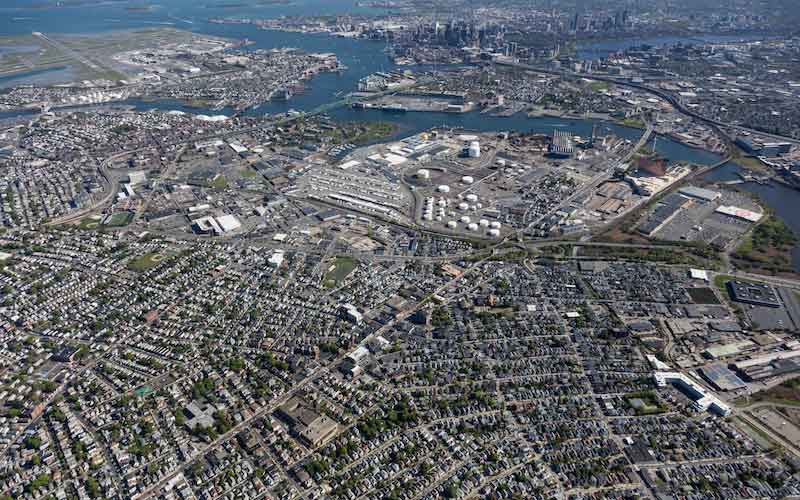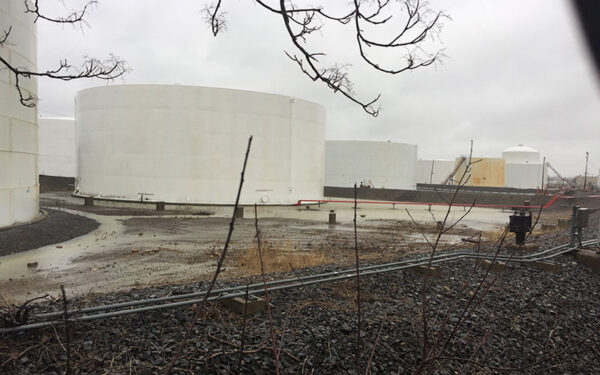
The communities hit first and worst by the COVID-19 pandemic – like Everett and Chelsea, Massachusetts [pictured] – are also those hit hardest by excessive pollution, structural racism, and generational poverty. Rather than return to the old "normal," we have a chance to address these disparities and more with strategic investment and innovation. Photo: Alex MacLean
As states begin to lift their stay-at-home directives, none of us can say if or when our lives will return to “normal.” But “normal” was never especially great for many people, as the pandemic has put in stark relief. Communities of color and low-income communities have been hit hardest by the coronavirus, exposing the inequities caused by excessive pollution, structural racism, housing segregation, and generational poverty.
We now have the rare chance to envision a new “normal.” Rather than double down on the status quo, we should seize this moment to invest in safer and more resilient communities by addressing the root causes of pervasive health, economic, and environmental disparities.
Sadly, the status quo is reflected in bipartisan proposals now pending in Congress to prop up dirty fossil fuels with more subsidies. This true-to-the-past approach would sacrifice our health and climate for limited and dubious economic gain. And we once again would be abandoning the most vulnerable among us, ignoring a shameful legacy of systemic injustices in which marginalized communities – with poor health and other harms – underwrite the prosperity of those most aligned with the old energy system and the old economy.
There are far better options. Federal and state recovery dollars could open a future of better health, broader prosperity, and a livable climate if state and regional leaders have the courage to restart our economy with vision and foresight. With targeted investment and innovation, the recovery can help forge stronger, more resilient, and more just communities in New England and beyond. In the coming weeks, we’ll take a closer look at each of these areas and highlight ways that you can help us advance the best solutions.
Investing Now in Resilient and Sustainable Infrastructure
The climate crisis looms large, and the pandemic has served as a grim reminder that ignoring such looming threats only makes them more expensive and devastating for our communities and the broader economy. Strategic investment of recovery dollars now can spur a just transition from dependence on oil, coal, and gas to sustainability, climate resilience, and economic stability.
Investments and incentives for energy efficiency, renewable energy, storage, and promising zero-carbon technologies will put people back to work, cut carbon emissions and health threats, save families money, and build resilient communities. Printing money for corporate handouts does none of these things. And, to avert catastrophic failures, any new infrastructure must be designed for the climate conditions expected over the life of the investment.
Transforming Our Transit Systems
The choices government leaders make now will affect both people’s access to transportation and the carbon pollution it creates for years to come. Recovery offers the chance to accelerate our transition away from single-occupancy gas-powered vehicles and antiquated transit systems. A full transition to electric buses and trains will reduce pollution and operational costs. More frequent service, fare-free trips, and expanded routes will take cars off the road, clean up air pollution hot-spots, and get people to work on time. For car-dependent suburban and rural communities, investments in electric charging infrastructure can expand zero-carbon transportation options. These smart investments will not only improve the health of our communities but also that of our climate and economy.
Safeguarding Our Water from Toxic Contamination
We can no longer take the safety of our drinking water for granted due to its widespread contamination with toxic “forever” chemicals, lead, and other dangerous contaminants. The American Society of Civil Engineers has given our country’s drinking water infrastructure a grade of D+: barely passing. To protect public health and help get our economy back on track, we need health-based standards for toxics in drinking water. And, those standards must be supported by investments to replace leaking old pipes, update treatment systems, and modernize outdated wastewater treatment systems.
Building Healthier Neighborhoods
As highlighted in a recent report by Massachusetts Attorney General Maura Healy, the pandemic has been especially lethal in communities exposed to excessive pollution. These same communities lack housing quality and stability, access to reliable transportation, jobs, green space, and healthy food.
Investments in recovery and rebuilding must take all of these factors into account and direct resources to healthy housing models serving those communities that are overburdened by environmental pollution and poor health.
Securing Open Space and Creating Thriving Ecosystems
Healthy forests, wetlands, and floodplains filter water pollution, store carbon, provide critical habitat to fish and wildlife, and reduce risk to communities on the frontlines of climate change and natural disasters. Restoring and protecting our natural systems can help drive our recovery by putting engineers, construction workers, landscapers, and others back to work.
Access to the outdoors has been at a premium during the pandemic, so we also should prioritize infrastructure investments that expand local public and recreation options or increase access to nature – all of which boost our health and resilience both mentally and physically.
Strengthening Our Food Systems and Ensuring Greater Food Access
This moment has revealed the fragility of food access across all of our communities – including the critical role of producers within New England’s foodshed. If we are to increase the resilience of our communities and our economy to climate change, pandemic, and other emerging risks, we need to bolster the economic viability of the region’s small and sustainable farms and food businesses. And we need to strengthen (and in some cases create) the networks and resources that get food to the people who need it the most, including more and safer access to places for them to grow their own. Incentives for regenerative and sustainable agriculture also will have long-term benefits for the health of our climate.
Even as we mourn the lives lost to COVID-19 and absorb the heavy toll it has taken on our economy, we must recognize that the old “normal” left too many communities unhealthy and especially vulnerable to the pandemic. Replicating that old “normal” will squander this unique chance to reduce climate danger while building healthier and more just communities for all.



